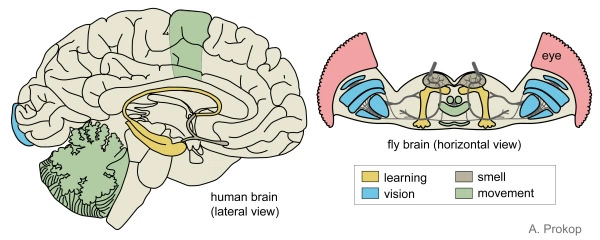November 5, 2019 at Rutledge Cab Co., Charleston, SC
Presented by:
Dr. Chris Korey, Professor of Neurobiology, College of Charleston, Department of Biology
Marielena Martinez, local artist and STEAM educator

The human brain is a mind-blowing network of neurons and chemicals, blood vessels and connective tissues, salts, and electricity. Together they control our perceptions, thoughts, and actions. Dr. Chris Korey's lab advances our understanding of how the nervous system works through the tiny brains of fruit flies. So how different are we? What are scientists learning thanks to these little guys and other model systems? Be prepared to be surprised. Chris leads a highly active undergraduate research lab that in true liberal arts fashion intersects across disciplines and departments, including the Center for Academic Performance & Persistence and Women’s & Gender Studies. “Ninjas vs. professors” -- you’d be forgiven if you confused Dr. Chris Korey for either. And in her own ninja-esque fashion, Marielena Martinez will introduce us to techniques to harness our left brain versus right brain skills for drawing. Think you don’t have a strong “artsy” brain...Wait till you see what your right side can create!
About the Science:
The final Cultivate happy hour of 2019 occurred at a new location, Rutledge Cab Co., and the atmosphere was lively! Dr. Chris Korey taught attendees a new reason we should care about the tiny pest so many of us are all too familiar with, the fruit fly. Humans and fruit flies share 60% of their DNA, making research on tiny fly brains very useful and applicable to human applied research. The fruit fly, scientifically known as Drosophila melanogaster, is considered a "model organism" due to its shared genes with humans, small size, simple lifestyle, and rapid reproduction life cycles. Other model organisms you may be more familiar with are mice and frogs. Fruit flies have been used as a model organism in scientific research for over 100 years!
Contrary to what many people may believe, fruit flies have very complex behaviors and are considered by scientists like Dr. Korey to be fairly sophisticated beings. Despite some obvious size differences, fruit flies possess distinct areas of the brain similar to humans, including areas designated for learning, vision, smell, and movement. These organisms can even have similar physical experiences to humans, such as being drunk, blind, having seizures, disorientation, and addiction. We learned that fruit flies also have about 75% of the same disease genes that humans have! This makes them vital to preliminary research on drugs and other investigative first steps in medical science. Very interesting work on fruit flies has occurred in stem cells and sleep studies.
Dr. Korey explained how the same gene in flies, mice, zebrafish, and humans can affect the development of all those organisms' eyes, demonstrating the basic body similarity between many living creatures. Similar to eyes, fly brains are being used to further research on human brains. Recent work in Dr. Korey’s lab has been using fruit flies to better understand the neurodegenerative illness called Battens Disease. The symptoms of Battens Disease appear similar in fruit flies and humans; both will begin to experience a gradual loss of vision, mental decline, ataxia, and seizures. Through the testing of fruit fly responses to potential treatment methods for battens disease, scientists are searching for a solution to the neurodegenerative illness. It just goes to show you, though we think we are unique, humans are much more similar to all the other living things, big and small, on this Earth.
About the Art:
Marialena Martinez incorporated our new appreciation of the brain from Dr. Korey’s engaging presentation into mental jujitsu for drawing. She introduced us all to some surprising techniques to free our self-editing and empower our creative side to let our inner artist flow. This art was a four-step process of sketching an image using four different techniques. First artists were told to look at the image they chose and sketch it as they normally would. Next, everyone was instructed to draw the same image but with a single “contour” line -- that meant no picking the drawing utensil up until the image was complete! The third image was drawn with the artists’ non-dominant hand. Then we were instructed to draw the final image upside-down! We were all intrigued and amazed at the skills unleashed by these different techniques. Who would have imagined the ability of our brains to recreate an image when pressured to perform in unique ways! One very interesting observation we noticed was that many people reversed their image right to left when drawing upside down. The functioning of our brains is truly fascinating and we have much still to learn.
Want to Learn More?









Comments